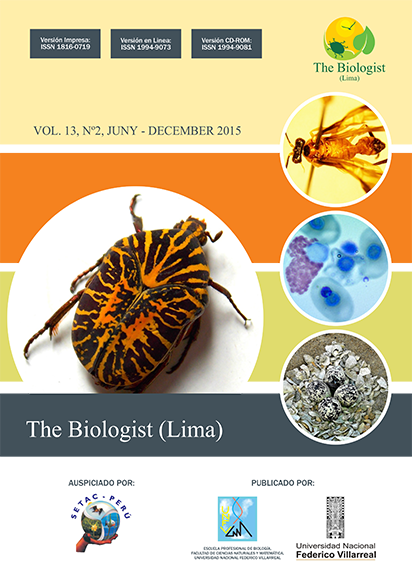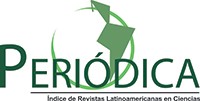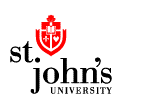DIVERSIDAD ENTOMOLÓGICA ENTRE UN ECOSISTEMA EN PROCESO DE REGENERACIÓN NATURAL Y UN BOSQUE PRIMARIO, AMAZONAS, PERU
DOI:
https://doi.org/10.24039/rtb20151321549Palavras-chave:
Amazonas, bosque primario, ecosistema en proceso de regeneración natural, estacionalidad, inventario entomológicoResumo
La región Amazonas peruana viene experimentando una serie de impactos como la deforestación que produce pérdida de la cubierta vegetal y como consecuencia de la reducción del hábitat para la fauna. El objetivo de este trabajo fue evaluar la diversidad entomológica entre un ecosistema en proceso de regeneración natural (BS) y un bosque primario (BP) en Bongará, Amazonas, Perú. Los insectos se obtuvieron mediante el uso de trampas de caída, cebo y Malaise, las que fueron dispuestas en un sistema en cruz teniendo como punto medio el centro de cada área. La colecta se realizó durante tres épocas: seca, semi-seca y lluviosa. Se clasificaron 18650 insectos de 150 familias distribuidas en 13 órdenes. Los Ordenes que presentaron mayor porcentaje de riqueza y
abundancia, respectivamente fueron Diptera (24%; 45,2%), Coleoptera (24%; 26,4%) e Hymenoptera (21,3%; 14%). Al comparar las dos áreas evaluadas, el BP presentó una mayor abundancia en comparación al BS. Las dos familias más abundantes fueron Drosophilidae y Staphylinidae. Una mayor abundancia y riqueza se presentó en la época semi-seca y seca en comparación al periodo lluvioso. Se observaron los valores más bajos en la riqueza específica de familias, así como en la abundancia y en Shannon-Wiener para el ecosistema en regeneración natural-periodo lluvioso. La similitud de las familias de insectos entre las dos áreas evaluadas con diferente grado de intervención antrópica presentaron pocas familias compartidas. El periodo lluvioso presentó un menor grado de similaridad entomológica a nivel de familia en comparación a las épocas seca y semi-seca. La abundancia y diversidad de la entomofauna puede ser empleada como un bioindicador de impacto antrópico y de época del año evaluado en el ambiente boscoso.
Downloads
Downloads
Publicado
Como Citar
Edição
Seção
Licença

Este trabalho está licenciado sob uma licença Creative Commons Attribution-NonCommercial-NoDerivatives 4.0 International License.
Objeto: El AUTOR-CEDENTE transfiere de manera TOTAL Y SIN LIMITACIÓN alguna al CESIONARIO (Revista The Biologist (Lima)) los derechos patrimoniales que le corresponden sobre sus obras por el tiempo que establezca la ley internacional. En virtud de lo anterior, se entiende que el CESIONARIO adquiere el derecho de reproducción en todas sus modalidades, incluso para inclusión audiovisual; el derecho de transformación o adaptación, comunicación pública, traducción, distribución y, en general, cualquier tipo de explotación que de las obras se pueda realizar por cualquier medio conocido o por conocer en el territorio nacional o internacional.
Remuneración: La cesión de los derechos patrimoniales de autor que mediante este contrato se hace será a título gratuito.
Condiciones y legitimidad de los derechos: El AUTOR-CEDENTE garantiza que es propietario integral de los derechos de explotación de la(s) obra(s) y en consecuencia garantiza que puede contratar y transferir los derechos aquí cedidos sin ningún tipo de limitación por no tener ningún tipo de gravamen, limitación o disposición. En todo caso, responderá por cualquier reclamo que en materia de derecho de autor se pueda presentar, exonerando de cualquier responsabilidad al CESIONARIO.
Licencia de acceso abierto: El AUTOR-CEDENTE autoriza que manuscrito publicado en la Revista Científica The Biologist (Lima) (versión Impresa ISSN 1816-0719, versión en línea ISSN 1994-9073) permanece disponible para su consulta pública en el sitio web http://revistas.unfv.edu.pe/index.php/rtb/index y en los diferentes sistemas de indexación y bases de datos en las que la revista tiene visibilidad, bajo la licencia Creative Commons, en la modalidad Reconocimiento-No comercial- Sin Trabajos derivados –aprobada en Perú, y por lo tanto son de acceso abierto. De ahí que los autores dan, sin derecho a retribución económica, a la Escuela Profesional de Biología, Facultad de Ciencias Naturales y Matemática de la Universidad Nacional Federico Villarreal (EPB - FCCNM - UNFV), los derechos de autor para la edición y reproducción a través de diferentes medios de difusión.









































